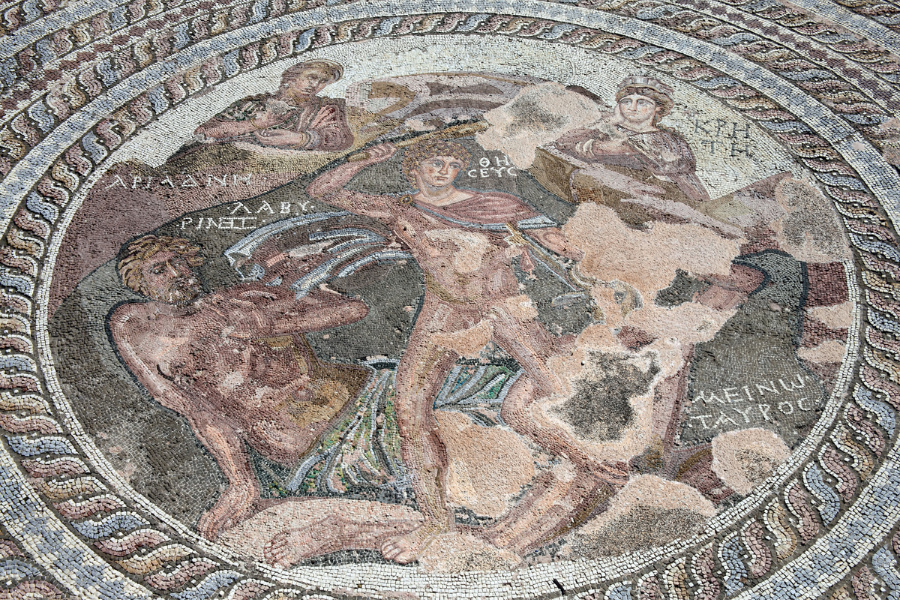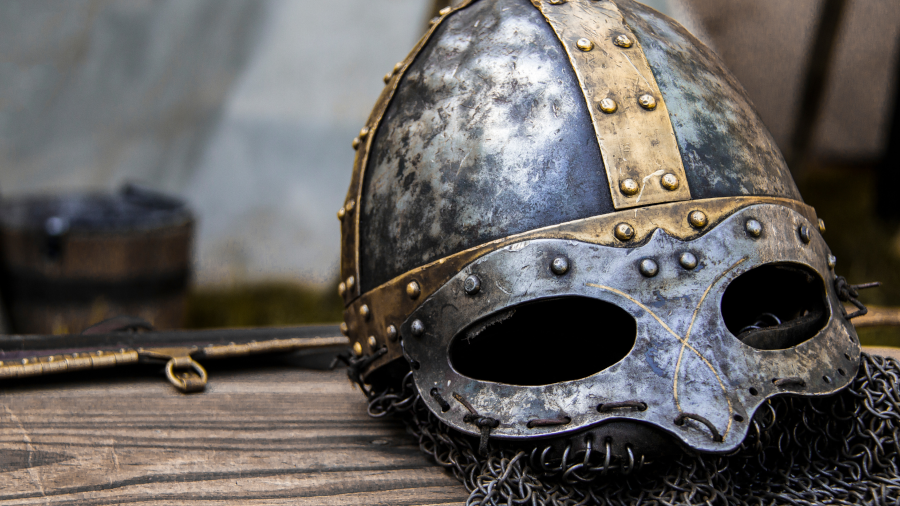Hello fellow crossword lovers!
I’ve always been fascinated by the intricate world of crosswords. From my morning ritual of diving into the daily puzzle with a cup of coffee in hand to those long Sunday afternoons spent deciphering cryptic clues, crosswords have been an enduring passion of mine.
However, one theme that kept popping up, often leaving me stumped, was Egyptian mythology. Have you ever been faced with a 6-letter clue hinting at an Egyptian deity and found yourself drawing a blank? I certainly have!
The rich tapestry of Egyptian mythology, with its pantheon of deities and intriguing legends, has left an indelible mark on modern culture, literature, and yes, our beloved crosswords.
Whether it’s the sun god with a falcon head or the powerful goddess of magic and motherhood, these figures have become mainstays in puzzles worldwide. And I’ve come to realize that having a handy guide to these gods, especially categorized by letter count, can be a game-changer.
In this guide, we’ll dive into the captivating world of Egyptian deities, exploring their stories, symbols, and most importantly for us crossword enthusiasts, their names. So, the next time you’re confronted with a clue like “Egyptian god of the afterlife, 4 letters,” you’ll be ready!
Happy solving!
The Pantheon At A Glance: Most Commonly Known Gods
Ancient Egyptian mythology has been a constant source of fascination for millennia. But with such an expansive pantheon of gods and goddesses, where does one begin? While scholars might be drawn to the most obscure deities, popular culture has its favorites. Let’s take a look at the gods that frequently pop up, from crossword puzzles to movies.
Popular Gods in Crosswords and Pop Culture

Ra (or Re) – (2 Letters): The sun god, one of the most fundamental deities in the Egyptian pantheon. He was believed to travel the sky in a sun barque and to journey through the underworld at night.
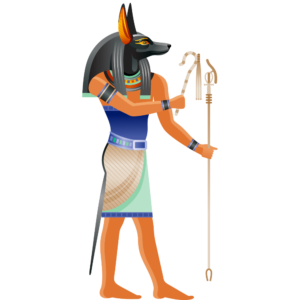
Anubis – (6 Letters): The jackal-headed god of mummification and the afterlife. Known for guiding souls and weighing the heart of the deceased against the feather of Ma’at (truth).
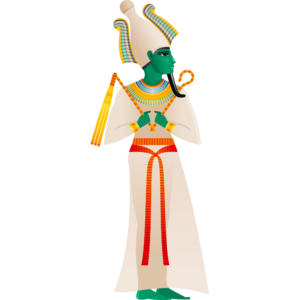
Osiris – (6 Letters): The god of the dead, resurrection, and fertility. His myth with his wife, Isis, and brother, Set, is one of the most well-known stories in Egyptian mythology.
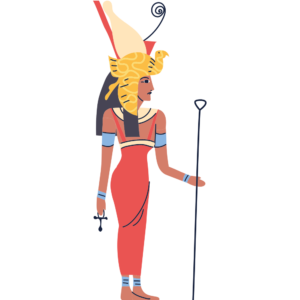
Isis – (4 Letters): Goddess of magic, motherhood, and healing. She played a pivotal role in the story of Osiris, searching for his body parts scattered across Egypt by Set.
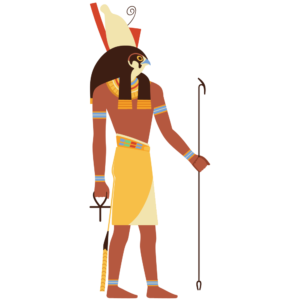
Horus – (5 Letters): The falcon-headed god, son of Osiris and Isis. He symbolizes the living pharaoh and is known for his eye, which represents protection and healing.

Cleopatra – (9 Letters): While not a deity, this last active pharaoh of Ancient Egypt often finds her way into crosswords and is intrinsically tied to the mythology and history of the region.
List of Egyptian gods by number of characters in their name

I’ve meticulously compiled this section for your convenience. I’ve seen that sometimes, it’s not just the hint but the number of boxes that give away a clue in crosswords.
This list is designed to help you quickly pinpoint potential answers based on the length of the deity’s name, ensuring a smoother and more efficient puzzle-solving experience. Dive in, and let this tailored list be your guide to Egyptian-themed crossword triumphs!
2 Letters
- Ha
- Ra
- Nu
- Ba
- Up
- Ur
3 Letters
- Heh
- Kek
- Ati
- Ḥeb
- Bes
- Iah
- Ipy
- Min
- Geb
- Set
- Shu
- Bat
- Mut
- Nut
- Ảri
- Maa
- Men
- Neb
- Ảmi
- Neb
4 Letters
- Shai
- Hapi
- Aqen
- Serq
- Untả
- Upit
- Ur-ā
- Ahti
- Babi
- Buto
- Heka
- Tutu
- Unut
- Aker
- Amun
- Aten
- Atum
- Hapi
- Ptah
- Isis
- Maat
- Urit
5 Letters
- Anput
- Athpi
- Unnti
- Ảriti
- Ḥebit
- Maa-ā
- Unnit
- Anqet
- Dedun
- Meret
- Qebui
- Satis
- Weneg
- Anhur
- Bennu
- Horus
- Khnum
- Montu
- Nemty
- Neper
- Sobek
- Sopdu
- Thoth
- Heqet
- Hesat
- Neith
- Nepit
- Satet
- Ȧakhu
- Neter
- Ḥunit
6 Letters
- Medjed
- Anubis
- Kauket
- Ảmi-Nu
- Ȧmi-Pe
- Ảmi-ta
- Ảmi-ut
- Antywy
- Unnuit
- Am-heh
- Ba-Pef
- Mafdet
- Mekhit
- Qetesh
- Serqet
- Seshat
- Shezmu
- Wepset
- Khepri
- Khonsu
- Maahes
- Osiris
- Amunet
- Anuket
- Bastet
- Hathor
- Menhit
- Pakhet
- Tefnut
- Wadjet
- Wosret
- Khenti
7 Letters
- Tatenen
- Ȧmi-beq
- Ảmi-haf
- Ảmi-kar
- Ảmi-reţ
- Ḥutchai
- Āpertra
- Hetemit
- Amentet
- Andjety
- Imhotep
- Resheph
- Tatenen
- Taweret
- Tenenet
- Imentet
- Nekhbet
- Sekhmet
8 Letters
- Ḥun-sāḥu
- Nekenher
- Ba-khati
- Heryshaf
- Kebechet
- Mandulis
- Nehebkau
- Nefertum
- Wadj-wer
- Hatmehit
- Nephthys
9 Letters
- Hedjhotep
- Ảmi-keḥau
- Ảmi-neter
- Meskhenet
- Raet-Tawy
- Ta-Bitjet
- Tjenenyet
- Renenutet
10 Letters
- Ảmi-naut-f
- Ảmi-nehţ-f
- Ảmi-seḥseḩ
- Ảmi-sepa-f
- Ảmi-suḥt-f
- Ảrit-ȧakhu
- Werethekau
- Un-baiusit
11+ Letters
- Neb au-t-ȧb
- Netrit fent
- Maa-neter-s
- Arensnuphis
- Ảmi-sekhet-f
- Ảnmut-făbesh
- Nebethetepet
- Baiut-s-ảmiu-heh
- Neterit-nekhenit-Rā
- Ami-Ḥe-t-Serqet-Ka-hetep-t
Gods Categorized by Gender

I’ve crafted this section especially for you. Recognizing the frequent occurrence of clues related to deities’ genders in puzzles, I aimed to streamline your searching process.
By categorizing gods based on gender, I hope to make it simpler for you to narrow down potential answers and swiftly match the gaps in your puzzle with a gender-specific clue. May this list aid in your quest for crossword mastery!
Male Egyptian Gods:
| Name | Gender | Letters |
|---|---|---|
| Ha | Male | 2 |
| Ba | Male | 2 |
| Up | Male | 2 |
| Ur | Male | 2 |
| Ati | Male | 3 |
| Ḥeb | Male | 3 |
| Bes | Male | 3 |
| Iah | Male | 3 |
| Min | Male | 3 |
| Geb | Male | 3 |
| Set | Male | 3 |
| Shu | Male | 3 |
| Ảri | Male | 3 |
| Maa | Male | 3 |
| Men | Male | 3 |
| Neb | Male | 3 |
| Aqen | Male | 4 |
| Serq | Male | 4 |
| Untả | Male | 4 |
| Ahti | Male | 4 |
| Babi | Male | 4 |
| Heka | Male | 4 |
| Tutu | Male | 4 |
| Aker | Male | 4 |
| Amun | Male | 4 |
| Aten | Male | 4 |
| Atum | Male | 4 |
| Hapi | Male | 4 |
| Ptah | Male | 4 |
| Athpi | Male | 5 |
| Unnti | Male | 5 |
| Dedun | Male | 5 |
| Qebui | Male | 5 |
| Weneg | Male | 5 |
| Anhur | Male | 5 |
| Bennu | Male | 5 |
| Horus | Male | 5 |
| Khnum | Male | 5 |
| Montu | Male | 5 |
| Nemty | Male | 5 |
| Neper | Male | 5 |
| Sobek | Male | 5 |
| Sopdu | Male | 5 |
| Thoth | Male | 5 |
| Ȧakhu | Male | 5 |
| Neter | Male | 5 |
| Ảmi-Nu | Male | 6 |
| Ȧmi-Pe | Male | 6 |
| Ảmi-ta | Male | 6 |
| Ảmi-ut | Male | 6 |
| Antywy | Male | 6 |
| Am-heh | Male | 6 |
| Ba-Pef | Male | 6 |
| Shezmu | Male | 6 |
| Khepri | Male | 6 |
| Khonsu | Male | 6 |
| Maahes | Male | 6 |
| Osiris | Male | 6 |
| Khenti | Male | 6 |
| Ȧmi-beq | Male | 7 |
| Ảmi-haf | Male | 7 |
| Ảmi-kar | Male | 7 |
| Ảmi-reţ | Male | 7 |
| Ḥutchai | Male | 7 |
| Andjety | Male | 7 |
| Imhotep | Male | 7 |
| Resheph | Male | 7 |
| Tatenen | Male | 7 |
| Ḥun-sāḥu | Male | 8 |
| Nekenher | Male | 8 |
| Heryshaf | Male | 8 |
| Mandulis | Male | 8 |
| Nehebkau | Male | 8 |
| Nefertum | Male | 8 |
| Wadj-wer | Male | 8 |
| Ảmi-keḥau | Male | 9 |
| Ảmi-neter | Male | 9 |
| Ảmi-naut-f | Male | 10 |
| Ảmi-nehţ-f | Male | 10 |
| Ảmi-seḥseḩ | Male | 10 |
| Ảmi-sepa-f | Male | 10 |
| Ảmi-suḥt-f | Male | 10 |
| Arensnuphis | Male | 11 |
| Ảmi-sekhet-f | Male | 12 |
| Ảnmut-făbesh | Male | 12 |
| Ami-Ḥe-t-Serqet-Ka-hetep-t | Male | 26 |
Female Egyptian Gods:
| Name | Gender | Letters |
|---|---|---|
| Ipy | Female | 3 |
| Bat | Female | 3 |
| Mut | Female | 3 |
| Nut | Female | 3 |
| Buto | Female | 4 |
| Unut | Female | 4 |
| Isis | Female | 4 |
| Maat | Female | 4 |
| Anqet | Female | 5 |
| Meret | Female | 5 |
| Satis | Female | 5 |
| Heqet | Female | 5 |
| Hesat | Female | 5 |
| Neith | Female | 5 |
| Nepit | Female | 5 |
| Satet | Female | 5 |
| Mafdet | Female | 6 |
| Mekhit | Female | 6 |
| Qetesh | Female | 6 |
| Serqet | Female | 6 |
| Seshat | Female | 6 |
| Wepset | Female | 6 |
| Amunet | Female | 6 |
| Anuket | Female | 6 |
| Bastet | Female | 6 |
| Hathor | Female | 6 |
| Menhit | Female | 6 |
| Pakhet | Female | 6 |
| Tefnut | Female | 6 |
| Wadjet | Female | 6 |
| Wosret | Female | 6 |
| Amentet | Female | 7 |
| Taweret | Female | 7 |
| Tenenet | Female | 7 |
| Imentet | Female | 7 |
| Nekhbet | Female | 7 |
| Sekhmet | Female | 7 |
| Kebechet | Female | 8 |
| Hatmehit | Female | 8 |
| Nephthys | Female | 8 |
| Meskhenet | Female | 9 |
| Raet-Tawy | Female | 9 |
| Ta-Bitjet | Female | 9 |
| Tjenenyet | Female | 9 |
| Renenutet | Female | 9 |
| Werethekau | Female | 10 |
| Nebethetepet | Female | 12 |
Unisex or Dual-Gendered Egyptian Gods:
| Name | Gender | Letters |
|---|---|---|
| Ra | Male & Female | 2 |
| Nu | Male & Female | 2 |
| Heh | Male & Female | 3 |
| Kek | Male & Female | 3 |
| Shai | Male & Female | 4 |
| Hapi | Male & Female | 4 |
| Anput | Male & Female | 5 |
| Medjed | Male & Female | 6 |
| Anubis | Male & Female | 6 |
| Kauket | Male & Female | 6 |
| Tatenen | Male & Female | 7 |
| Hedjhotep | Male & Female | 9 |
| Neb au-t-ȧb | Male & Female | 11 |
| Netrit fent | Male & Female | 11 |
Diving Deeper: Gods by Domains or ‘Jobs’
The ancient Egyptians had an intricate pantheon of deities, each with their unique domain or responsibility. These domains reflected the diverse facets of life and nature that the Egyptians deemed significant. By understanding these domains, one can better appreciate the complex tapestry of Egyptian religious and cultural beliefs. Here’s a closer look:
Egyptian Deity Clues: Creation & Cosmology

In the Egyptian worldview, the universe’s creation was a pivotal event, giving rise to various myths that explain the world’s origins. These myths varied between cities and periods, but some gods and concepts remained constant, signifying the deep-rooted belief in a cosmic order.
Atum: Originating from Heliopolis, Atum was the primeval god of the Ennead. Often portrayed as both male and female, Atum combined the elements of earth and sky. The deity was believed to have created itself from the waters of chaos (Nu), then proceeded to create the twin gods of air (Shu) and moisture (Tefnut).
Kek: One of the Ogdoad gods of Hermopolis, Kek represented the darkness before creation. Together with his female counterpart, Kauket, they symbolized the infinite night that existed before the world.
Nu (Nun): Often visualized as a vast expanse of dark, limitless waters, Nu was the primordial watery abyss. Before land, before gods, there was Nu. It’s within these waters that the first mound of land rose, giving a platform for the sun god Ra to stand upon.
Ra (Re): The supreme sun god, Ra, was not just a deity of light and warmth but also encapsulated the concept of creation. Every day, he was reborn and traveled across the sky, only to set and die, then to be reborn again the next day. This cyclical journey mirrored the process of creation, death, and rebirth.
Tatenen: Symbolizing the first mound of earth that emerged from the chaotic waters, Tatenen represented the first piece of solid ground on which creation could commence. This mound became a sacred symbol in Egyptian culture, representing the foundation of all life.
These deities and concepts depict how the ancient Egyptians perceived the universe’s birth. For them, creation was not a singular event but a continuous process, with the cosmos constantly regenerating, much like the Nile’s annual flooding that rejuvenated the land. Through these myths, the Egyptians sought to understand their place within this vast cosmos, finding solace in the idea that the gods maintained order and balance in the universe.
Egyptian Deity Clues: Afterlife & Death
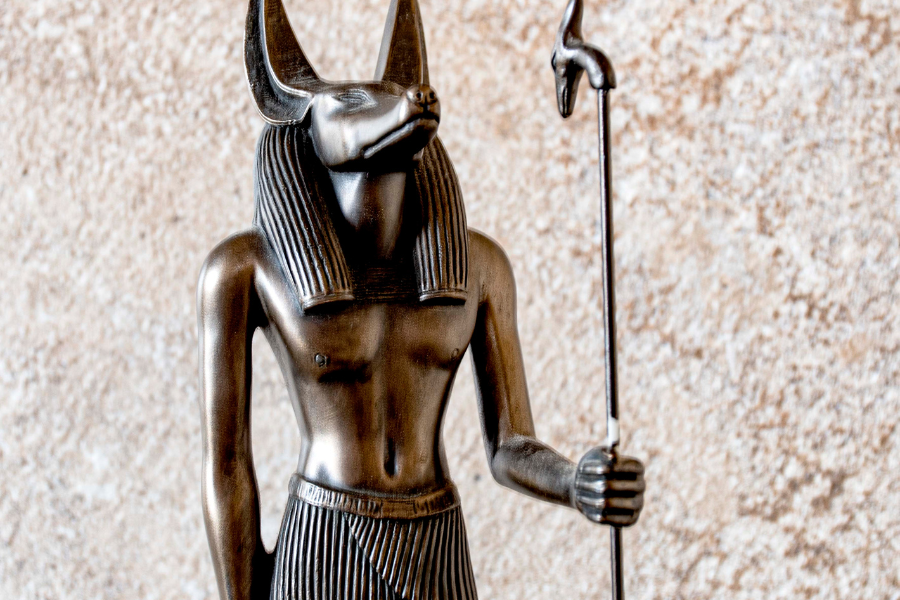
The concept of the afterlife was deeply ingrained in ancient Egyptian culture. For the Egyptians, death was not an end, but a transition to another realm where they could achieve eternal life. This belief was so profound that they invested significant resources and effort into ensuring a safe passage and a comfortable existence in the afterlife. Various gods played vital roles in this journey, offering protection, judgment, and guidance.
Osiris: As the god of the dead and resurrection, Osiris played a pivotal role in the afterlife. He was the judge of souls and the king of the Underworld. Those deemed worthy would be granted eternal life in the Field of Reeds, a paradise where souls could live peacefully, mirroring their earthly existence.
Anubis: Recognized by his jackal-headed appearance, Anubis was the god of mummification. He ensured that the deceased was prepared for the afterlife. Additionally, Anubis was a guardian and protector of the dead, guiding souls through the treacherous journey to the Hall of Maat for judgment.
Ma’at: Representing truth, balance, and order, Ma’at was essential in the judgment process. The deceased’s heart was weighed against the feather of Ma’at. If the heart was lighter, the soul was deemed pure and allowed to enter the afterlife. If not, it was devoured by Ammit, the devourer.
Thoth: Often depicted as an ibis or baboon, Thoth was the god of wisdom and writing. In the context of the afterlife, he played a crucial role as the scribe, recording the outcome of the soul’s judgment.
Horus: The falcon-headed god was a protector of the pharaoh and linked the mortal realm with the divine. In the afterlife context, Horus presented the soul of the deceased to his father, Osiris, for judgment.
Ammit: Not a god to be revered, Ammit, often depicted as a part lion, part hippopotamus, and part crocodile, was the devourer of souls. If one’s heart was heavier than Ma’at’s feather, Ammit would consume it, resulting in a second death from which there was no return.
The belief in the afterlife led to the construction of grand tombs, intricate burial practices, and the penning of the Book of the Dead, a guide to help the deceased navigate the challenges of the afterlife. The gods associated with death and the afterlife were not feared but revered, as they held the keys to eternal life and were vital in ensuring a soul’s safe passage to the Field of Reeds.
Egyptian Deity Clues: Nature & Elements
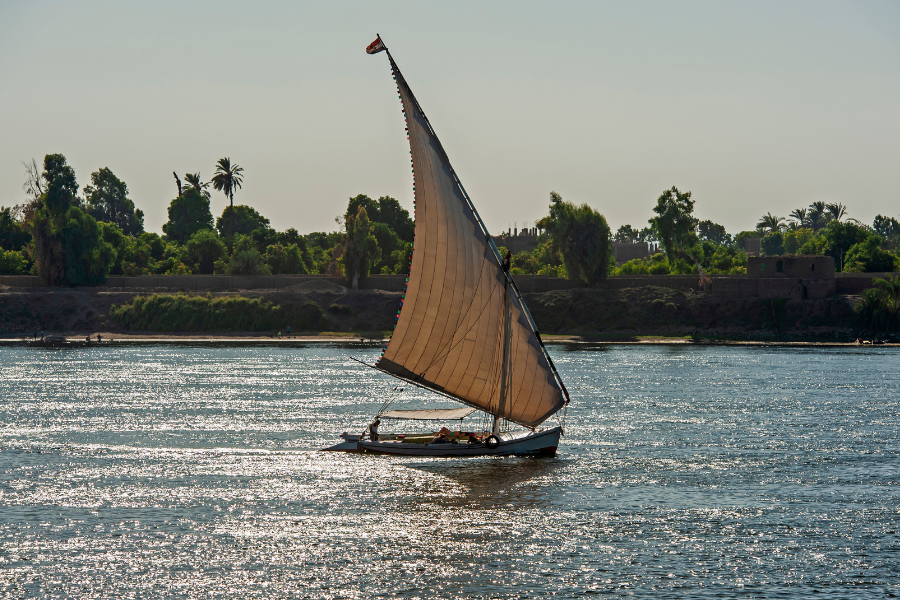
The ancient Egyptians held a profound respect for the natural world, understanding its rhythms, its unpredictability, and its power. Their pantheon reflected this reverence, with many deities embodying the elements and natural phenomena that shaped their daily lives. These gods and goddesses were essential, serving as a bridge between humans and the forces of nature.
Ra (Re): As the sun god, Ra was one of the most prominent deities in Egyptian mythology. Every morning, he was believed to be reborn and would travel across the sky, bringing light and warmth. By evening, he would die, only to be reborn the next day, symbolizing the eternal cycle of the sun.
Nut: The sky goddess, Nut, was often depicted arching over the earth, her body dotted with stars. She was the barrier between the chaos of the outer universe and the ordered world.
Geb: Representing the earth, Geb was often portrayed lying beneath Nut. He symbolized the fertile land of Egypt and was considered the father of snakes.
Tefnut: The goddess of moisture, dew, and rain, Tefnut was vital for the arid landscape of Egypt. She was often depicted as a lioness or as a woman with a lion’s head.
Shu: Symbolizing the air, Shu held the sky (Nut) away from the earth (Geb), creating the atmosphere. He also represented the space between them, which allowed life to flourish.
Hapi: Personifying the Nile flood, Hapi was crucial for the Egyptians. The annual inundation brought fertility to the lands, ensuring successful harvests. He was often depicted with papyrus (symbolizing Upper Egypt) and lotus (symbolizing Lower Egypt).
Seth (Set): Representing chaos, deserts, and storms, Seth was both revered and feared. While he brought chaos, he also protected Egypt from external threats, showcasing the dual nature of this deity.
Nephthys: Goddess of the night, transition, and protective funerary rites, Nephthys was often invoked to provide protection against the perils of the desert and the darkness.
Nature was not just a backdrop for the ancient Egyptians; it was a living entity, filled with divine energy. By honoring the gods of nature and elements, the Egyptians sought harmony, protection, and blessings in their daily lives and their interactions with the world around them.
Egyptian Deity Clues: Protection & War
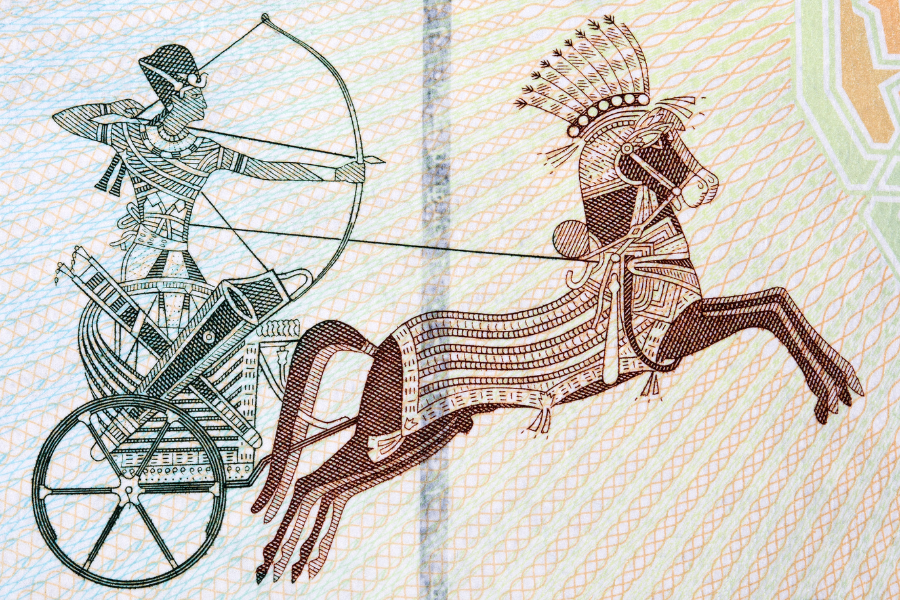
In a world where external threats and internal conflicts were ever-present, the ancient Egyptians sought the favor of gods and goddesses who could offer protection, guide them in battle, and ensure the nation’s safety. These deities were revered not only by soldiers but also by ordinary citizens, who invoked their protection against various dangers.
Anubis (and Anput): While primarily known as the god of mummification, Anubis also played a protective role, especially in safeguarding the dead during their journey to the afterlife. Anput, his female counterpart, shared similar protective functions.
Seth (Set): A complex deity, Seth was the god of chaos, but he also played a pivotal role as a defender of Egypt, especially against foreign threats. His fierce nature was both a boon and a challenge for the Egyptians.
Horus: A sky god symbolized by a falcon, Horus was often invoked as a protective deity. As a god of kingship, he was also associated with the power and might of the pharaoh, the ultimate protector of Egypt.
Sekhmet: A lioness goddess, Sekhmet was a force to be reckoned with. She was the goddess of war, bringing destruction to the enemies of Egypt, but she was also invoked for protection against various evils.
Maahes: Often depicted as a lion-headed man carrying a knife, Maahes was a god of war and protection. He was also associated with the heat of the sun, symbolizing his fierce nature.
Bastet: Initially a lioness goddess of war, Bastet’s role evolved over time. She became associated with domestic cats and took on a protective role, especially in households and against evil spirits.
Wepwawet: Often portrayed as a wolf or a jackal, Wepwawet was a god of war and a protector of the pharaoh during battles. His name means “Opener of the Ways,” signifying his role in guiding the army and removing obstacles.
Neith: An ancient goddess of war and hunting, Neith was also considered a creator deity. She was often depicted with a shield and crossed arrows, symbolizing her protective and combative nature.
Ptah: While primarily a creator god and patron of craftsmen, Ptah also had protective aspects. He was invoked for protection, especially in the context of ensuring the structural integrity of buildings and other constructions.
The gods and goddesses of protection and war were essential figures in the Egyptian pantheon. They ensured the safety of the nation, its rulers, and its people from both tangible threats like enemies and intangible dangers like evil spirits. In invoking these deities, the Egyptians sought strength, courage, and the divine shield against harm.
Egyptian Deity Clues: Fertility & Procreation
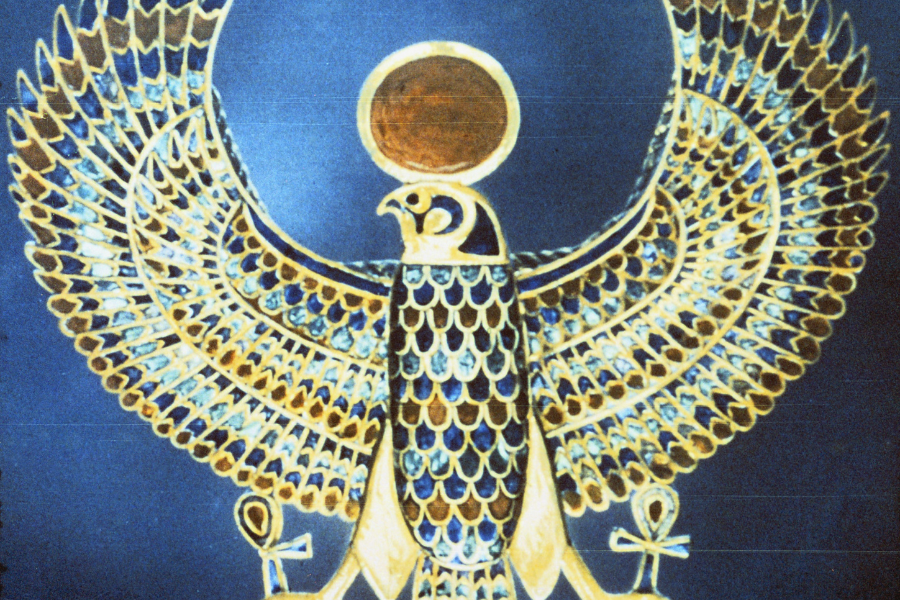
Fertility, both in terms of human procreation and the yield of the land, was of paramount importance to the ancient Egyptians. With the Nile’s annual flood nourishing their lands, the Egyptians recognized the delicate balance of life and the role of the divine in ensuring the continuation of their lineage and the prosperity of their crops. Several gods and goddesses played a role in these aspects of life:
Osiris: One of the most significant deities in the Egyptian pantheon, Osiris was not only a god of the afterlife but also a symbol of resurrection and fertility. His annual “resurrection” was intrinsically tied to the Nile’s flooding and the fertility it brought to the land.
Isis: As the wife of Osiris and mother of Horus, Isis was a symbol of motherhood and fertility. She was revered as the ideal mother and was often invoked for blessings of fertility and protection during childbirth.
Hathor: Often depicted as a cow goddess, Hathor was one of the primary deities of love, beauty, music, dance, and fertility. She was also the protector of women in childbirth.
Min: A god of fertility and procreation, Min was often depicted with an erect phallus, symbolizing virility. He was also the god of lettuce, a crop associated with fertility.
Taweret: This hippopotamus goddess was a protector of pregnant women and childbirth. Her fierce appearance was believed to ward off evil spirits that might harm mothers or their newborns.
Bes: A household god often depicted as a dwarf, Bes was a protector of families, especially pregnant women and young children. He was also associated with music and dance.
Nut: The sky goddess Nut was seen as the mother of all celestial beings. She was also associated with the protection and renewal of life, enveloping the deceased like a mother embracing her child.
Geb: As the earth god, Geb represented the fertile land of Egypt. He was often depicted lying beneath Nut, and together, they embodied the union of sky and earth, a critical aspect of fertility beliefs.
Fertility and procreation were not just about ensuring the continuation of the family lineage; they were also crucial for the survival and prosperity of the entire nation. By venerating these gods and goddesses, the Egyptians sought divine blessings to thrive in an environment where life was closely tied to the rhythms of nature.
Egyptian Deity Clues: Magic & Healing

In ancient Egypt, the boundaries between magic, medicine, and religion were fluid. Healing was seen as both a practical and spiritual matter, with deities playing central roles in providing remedies, protection, and magical knowledge. The power of heka (magic) was an intrinsic part of the Egyptian understanding of the world.
Isis: Renowned for her vast magical knowledge, Isis used her powers to resurrect her husband Osiris and protect her son Horus. Her magical spells and charms were invoked for healing and protection.
Thoth: As the god of wisdom, writing, and knowledge, Thoth was also associated with magic and healing. He was believed to have given humans the knowledge of medicine and was often invoked in spells and charms.
Sekhmet: Initially a warrior goddess, Sekhmet’s destructive power was also seen in terms of pestilence. However, she could also prevent diseases and was invoked for protection against epidemics.
Imhotep: Originally a deified architect and physician from the Old Kingdom, Imhotep later became associated with medicine and healing. He was often invoked as a healing deity, and his cult centers became places of pilgrimage for the sick.
Heka: Personifying the concept of magic itself, Heka was the deification of the magical power that pervaded the universe. He was sometimes depicted as assisting Ra in his boat, using his magical powers to repel the forces of chaos.
Serqet: While primarily a protective goddess against venomous creatures, Serqet’s protective aspect extended to the magical protection against venomous spells and enchantments.
Bes: Although known as a household protector, Bes also had a role in warding off evil spirits and was invoked for protection during childbirth, which was seen as a particularly vulnerable time requiring magical protection.
Nut: The sky goddess played a protective role, enveloping the deceased with her starry body and using her magical powers to assist in their rebirth in the afterlife.
In Egyptian society, priests, physicians, and magicians often overlapped in their roles. Temples were centers of healing, where medical treatments were provided alongside magical remedies. Magic and medicine were intertwined, and the gods were central to ensuring health, well-being, and protection from harmful forces.
Egyptian Deity Clues: Kingship & Leadership
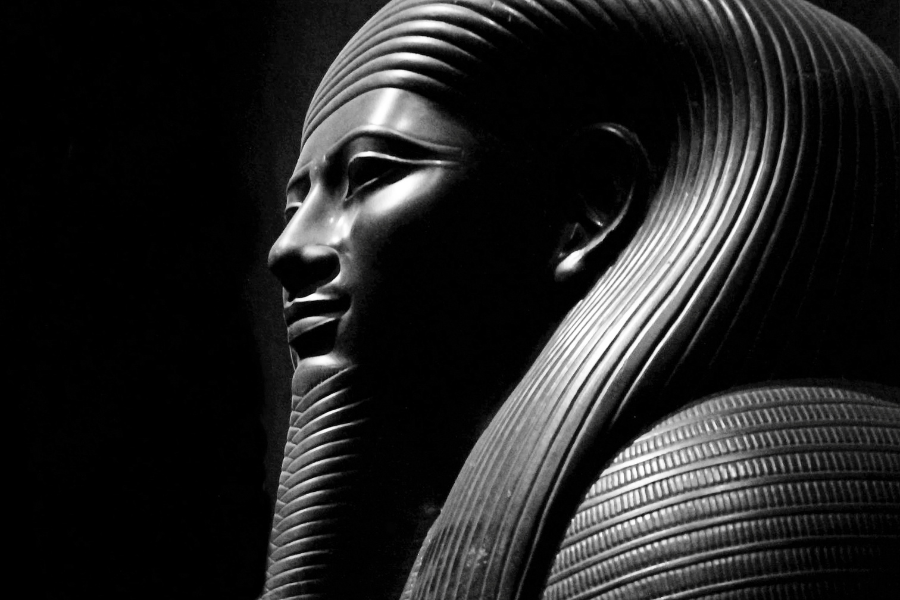
The concept of kingship was central to ancient Egyptian society and cosmology. The Pharaoh was not just a political leader but a divine one, serving as the intermediary between the gods and humans. This divine rulership was reinforced and symbolized by various deities who embodied aspects of kingship, authority, and leadership.
Ra (Re): As the foremost sun god and a primary creator deity, Ra’s daily journey across the sky mirrored the journey of the Pharaoh in ruling the land. Ra was also seen as the father of every Egyptian king.
Osiris: After his death and resurrection, Osiris became the ruler of the underworld. His story reflected the ideal of divine kingship, where the Pharaoh would join Osiris in death and be reborn.
Horus: Representing the living Pharaoh, Horus was the god of kingship and the sky. The reigning Pharaoh was considered the “Living Horus”, and his battles against Seth, the god of chaos, mirrored the earthly struggles for order and leadership.
Ma’at: The goddess of truth, balance, and order, Ma’at was central to the concept of divine kingship. The Pharaoh’s primary duty was to ensure Ma’at in the land, balancing both the cosmic and earthly realms.
Sobek: Associated with the Nile and military prowess, Sobek was seen as a protective deity. In the Middle Kingdom, he had a close association with the rulership, symbolizing the Pharaoh’s strength and might.
Atum: One of the creator gods, Atum represented the setting sun and was associated with the end of the day. He was linked with the concept of the complete cycle of life, death, and rebirth, reinforcing the cyclical nature of kingship.
Amun: Originating in Thebes, Amun grew in prominence to become a chief deity of the empire. He was fused with Ra (as Amun-Ra) and became a symbol of the hidden power behind creation and rulership.
Sekhmet: This lioness goddess, while primarily associated with war and healing, also had aspects related to kingship. Her fierce nature was invoked to protect the ruler and destroy his enemies.
The Pharaoh’s divine status was reinforced through rituals, festivals, and architecture. Temples and monuments served as a testament to the Pharaoh’s divine right to rule, drawing power and legitimacy from the gods. Throughout their reign, Pharaohs would seek the favor of these deities to ensure a prosperous and stable rule, reflecting the heavens on earth.
Egyptian Deity Clues: Wisdom & Knowledge

In ancient Egyptian culture, wisdom and knowledge were not just attributes of scholarly pursuit; they were divine principles integral to the order of the universe. Deities representing these domains provided guidance to the rulers and the people, ensuring the continuous flow of wisdom and understanding.
Thoth: Arguably the most prominent deity of wisdom, Thoth was the god of writing, knowledge, and the moon. He was credited with the invention of writing and was considered the scribe of the gods. Thoth played a crucial role in the maintenance of the universe and the arbitration of divine disputes. His wisdom was invoked by scribes and scholars.
Seshat: Often considered the female counterpart to Thoth, Seshat was the goddess of writing, architecture, and astronomy. She was seen as the recorder of history and the measurer of time, often depicted with a notched palm stem, which was used to record time.
Ma’at: While primarily the goddess of truth and order, Ma’at’s principles were deeply rooted in wisdom. Understanding and adhering to Ma’at was considered the highest form of wisdom in ancient Egypt.
Imhotep: Originally a historic figure—a vizier and architect under Pharaoh Djoser—Imhotep was deified after his death and worshipped as a god of wisdom, medicine, and architecture. His transition from mortal to deity underscores the profound respect ancient Egyptians had for wisdom and knowledge.
Osiris: Beyond his more known roles, Osiris was also seen as a god of agricultural knowledge. His resurrection story offered insights into the cycles of nature, and the wisdom inherent in understanding and harnessing them.
Ra (Re): As a sun god and creator deity, Ra possessed the ultimate knowledge of the cosmos. He knew the secrets of creation and the mysteries of life and death.
Anubis: While primarily a god of mummification and the afterlife, Anubis also possessed knowledge about the mysteries of death and the path to the afterlife. His role in the judgment of souls required a deep understanding of the heart’s truths.
Wepwawet: Often depicted as a jackal or a wolf, Wepwawet was a god of war but also associated with the opening of the ways, both in war and in the routes to the underworld. His understanding of these pathways signified a form of wisdom necessary for the journey of the afterlife.
Knowledge and wisdom were seen as divine gifts, essential for the maintenance of Ma’at (order) in the world. Temples, schools, and libraries were often dedicated to these deities, seeking their blessings and guidance in the pursuit of knowledge. Through understanding the wisdom of the gods, the ancient Egyptians believed they could live in harmony with the universe.
Egyptian Deity Clues: Music & Festivity

Music, dance, and festivity were integral components of ancient Egyptian culture, playing vital roles in religious ceremonies, celebrations, and daily life. The Egyptians believed that music had the power to soothe the heart, heal the soul, and communicate with the divine. Several deities were associated with these joyful and harmonious domains:
Hathor: Often referred to as the ‘Mistress of Music’, Hathor was the goddess of dance, music, joy, and love. She was depicted playing a tambourine or sistrum, a musical instrument closely associated with her. Festivals in her honor, like the Feast of Hathor, were filled with music, dance, and intoxication.
Bes: This dwarf god was the protector of households, mothers, and children. He was also the god of dance, music, and merriment. Bes was often depicted playing musical instruments, and his image was believed to evoke joy and ward off evil spirits.
Bat: Predating Hathor in some accounts, Bat was a goddess of music, fertility, and joy. Over time, she merged with Hathor, and the two shared many attributes, including the sistrum.
Ihy: Known as the ‘Sistrum Player’, Ihy was the god of music and was often depicted holding a sistrum. He was considered the son of Hathor and was closely associated with joy and celebration.
Ra (Re): While primarily the sun god, Ra was also associated with festivity. Hymns and songs were sung in his honor, especially during the daily ritual of the sun’s journey.
Osiris: In the context of his death and rebirth story, Osiris was associated with annual festivals. Music and dance were integral parts of the celebrations dedicated to Osiris, symbolizing life, death, and rebirth.
Seshat: Though primarily a goddess of writing and history, Seshat was also invoked during foundation ceremonies where music and dance were performed to ensure the building’s prosperity and longevity.
Ma’at: Chants and hymns dedicated to Ma’at were an essential part of rituals, reinforcing the principles of truth, balance, and order through music.
Music and dance in ancient Egypt were not just for entertainment; they were mediums to connect with the gods, celebrate life, and appease the divine.
Instruments like the sistrum, lyre, harp, and flutes were played during ceremonies, festivals, and other significant events. The harmonious sounds were believed to replicate the order of the universe and resonate with the very essence of creation. Through music and festivity, the ancient Egyptians celebrated the joys of life, honored their gods, and expressed their hopes and dreams.
Egyptian Deity Clues: Animals & Symbolism

Animals held significant symbolic importance in ancient Egyptian culture and mythology. The characteristics and behaviors of various animals were associated with specific deities, representing their powers and attributes. The reverence of animals in mythology highlighted the Egyptians’ understanding of the natural world and its deeper connections to the divine:
Anubis (Jackal): Associated with the jackal or the wild dog, Anubis was the god of mummification and the afterlife. Jackals, often seen in cemeteries, became symbols of death and rebirth.
Bastet (Lioness/Cat): Initially depicted as a lioness, representing her fierce protective nature, Bastet later became associated with the domesticated cat, symbolizing grace and affection.
Horus (Falcon): The falcon-headed god Horus represented the sky, kingship, and protection. The keen eyesight of the falcon symbolized the all-seeing nature of this deity.
Thoth (Ibis/Baboon): Thoth, the god of wisdom, writing, and the moon, was often depicted as an ibis or a baboon. The ibis, with its long beak, was a symbol of precise measurement and balance, while the baboon’s association with the moon linked it to Thoth’s lunar attributes.
Sekhmet (Lioness): A fierce warrior goddess, Sekhmet’s lioness form symbolized her destructive power and her role in protecting the pharaoh during war.
Sobek (Crocodile): Associated with the Nile crocodile, Sobek was a god of protection, fertility, and military prowess. The crocodile’s strength and ferocity made it a revered creature in Egyptian mythology.
Khepri (Scarab Beetle): Representing the rising sun, Khepri, depicted as a scarab beetle, symbolized rebirth, transformation, and protection. Scarab amulets were popular as protective charms.
Wadjet (Cobra): The cobra goddess Wadjet was a protective deity, often seen on the crown of the pharaohs. Her raised hood ready to strike embodied the pharaoh’s power and authority.
Taweret (Hippopotamus): A protective goddess of childbirth and fertility, Taweret’s hippopotamus form, with lion paws and a crocodile tail, combined the protective attributes of these animals to guard pregnant women and infants.
Hathor (Cow): Represented as a cow or a woman with cow’s horns, Hathor was a goddess of music, love, and joy. The cow’s nurturing nature symbolized Hathor’s protective and maternal attributes.
Apis (Bull): A sacred bull associated with the god Ptah and later linked with Osiris, Apis symbolized fertility, strength, and rebirth.
Ma’at (Ostrich Feather): While not an animal per se, the ostrich feather represented the concept of Ma’at, the goddess of truth, balance, and order. The feather was used in the weighing of the heart ceremony in the afterlife.
Animals in Egyptian mythology were not just revered for their physical attributes but were seen as embodiments of divine principles. Their symbolic representation in art, literature, and religious rituals showcased the Egyptians’ profound understanding of nature’s cycles, characteristics, and its intricate connection to the world of gods and spirituality.
Conclusion: Deciphering the Divine in Crossword Puzzles
From the winding banks of the Nile to the ornate hieroglyphs of towering pyramids, ancient Egypt has always held a mystique that captivates the imagination. Its pantheon of gods, vast and varied, is a testament to the civilization’s rich tapestry of stories, beliefs, and traditions. As we’ve explored, these deities, from the all-powerful Ra to the protective Anubis, have left their mark not just on history, but on popular culture as well, including the ever-challenging realm of crossword puzzles.
Crossword enthusiasts often find themselves face-to-face with clues that draw from the depths of Egyptian mythology. Whether it’s a hint pointing towards the falcon god Horus or the feline elegance of Bastet, these clues serve as both a challenge and a reminder of the indelible mark that ancient Egypt has left on our collective consciousness.
Moreover, understanding the nuances of each god, their domains, symbols, and the intricate web of relationships and stories surrounding them, can elevate the experience of solving these puzzles. It’s not just about filling in squares on a grid but about connecting with a civilization that, millennia ago, pondered on the same universal themes of life, death, love, war, and nature that we do today.
In closing, the next time you come across a hint in your crossword puzzle pointing towards the land of pharaohs and pyramids, take a moment to reflect. Behind that clue is a world of myths, legends, and beliefs that have shaped humanity’s understanding of the cosmos.
And as you ink in your answer, know that you’re not just solving a puzzle, but also connecting with a piece of history that continues to inspire, educate, and enthrall.
You might also find my article about Norse Gods and Goddesses in crossword clues useful.
Sources:
List of Egyptian deities – Wikipedia
Egyptian Gods – The Complete List – World History Encyclopedia
The 21 Main Egyptian Gods and Goddesses | Egyptian History (egyptian-history.com)

